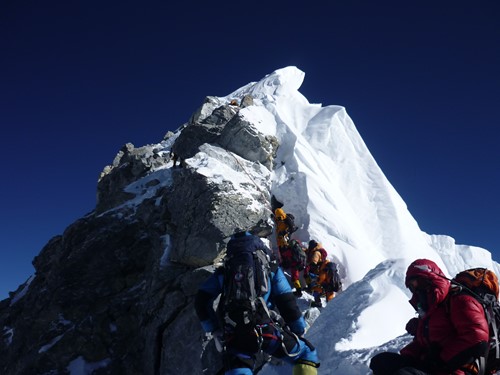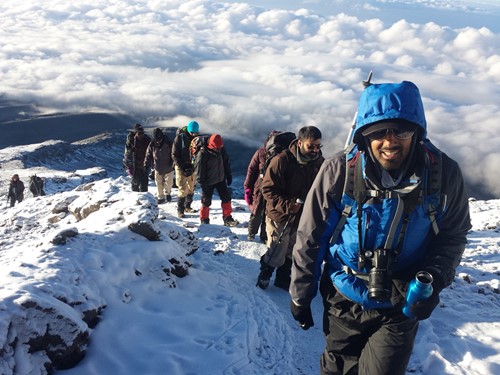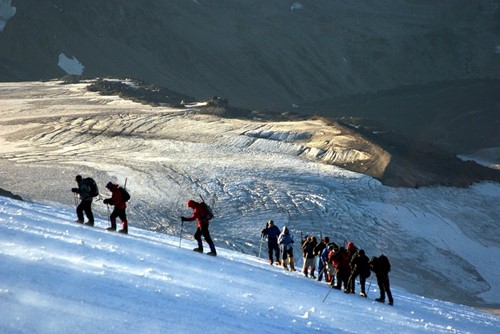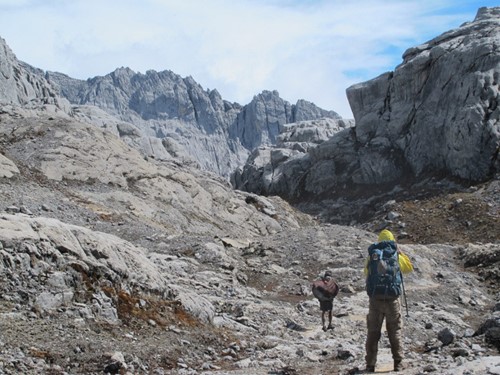Seven Summits
The 'Seven Summits' is a challenge first proposed and then completed by Richard Bass in 1985. It consists of climbing to the highest point on each of the seven continents:-
- Asia - Mt Everest - 8848m
- South America - Aconcagua - 6962m
- North America - Denali (Mt McKinley) - 6194m
- Africa - Mt Kilimanjaro - 5892m
- Europe - Mt Elbrus - 5642m
- Antarctica - Vinson Massif - 4892m
- Oceania - Carstensz Pyramid - 4884m
Since its original inception, the definition of the Oceana continent altered it slightly to include a peak in Indonesia in lieu of the previous one on mainland Australia. Pat Morrow, closely followed by Reinhold Messner, was the first to complete this second evolution of the challenge. Since then it has been completed in numerous more difficult ways including without supplementary oxygen (Messner) and within seven months (Rob Hall & Gary Ball). It has also been suggested that for an even more difficult mountaineering challenge one could climb the second-highest mountain on each of the continents as this would include more technical ascents such as K2.

The Hilary Step on Mount Everest, the tallest of the Seven Summits.
The Seven Summits remains a significant mountaineering challenge involving expeditions to all corners of the globe and significantly associated logistical and organisational requirements. Adventure Alternative is able to coordinate the logistics and organisation of all seven summits either individually or as part of a fully integrated expedition.
Please contact us for details of the summits not specifically listed elsewhere on the website or for individually tailored itineraries.
Information on the Seven Summits by Gavin Bate
Founder of Adventure Alternative and world-class mountaineer Gavin Bate gives his advice on the Seven Summits.
Mount Kilimanjaro, Tanzania
Mount Kilimanjaro is one of the Seven Summits, the highest peak in Africa, the highest free-standing mountain in the world and one of the most impressive peaks in the world. A volcanic giant alone on the savannah plains, snow-capped and remote, it is as evocative of the continent as the elephant - huge, stately and beautiful. People are irresistibly drawn to see it, while others try to scale its magnificent slopes. For mountain climbers, trekkers and adventurers Kilimanjaro is a perennial favourite, yet in my view, it is often underestimated as a challenge.
I have heard people who return from its high point talk of the "the hardest thing I've ever done". Then there are those who summit virtually on their hands and knees and wear the hardship like a badge of honour, perpetuating the idea that you've only ever climbed Kilimanjaro if you've gone beyond the limits of physical endurance, and perhaps sanity. To any mountaineer or guide, there is only one way to climb a mountain, and that is the safe way and consequently the enjoyable way.

Soaring high above the clouds on Kilimanjaro.
A climb of Kilimanjaro will take you, in a period of around seven days and 30 miles, from equatorial forest to glaciated summit, from one extreme of weather to the other, to the approximate altitude of Camp 1 on Mount Everest. A thousand metres higher than Mont Blanc, Kilimanjaro is not to be sniffed at; and yet people ascend with practically no knowledge of altitude-related illnesses, hardly aware even of the necessity to drink more water. Kilimanjaro is not a technical peak by the ordinary routes, but it does have objective dangers worthy of serious consideration.
I have been fortunate to climb Kilimanjaro many times. In 2005 I ascended the Western Breach for the 35th time and my total tally is currently 52. I find it stimulating and exciting, and never boring. Running my own operation means I employ the same staff, and they are all my friends now so that makes it all the more fun. I love listening to the life stories of clients who come with me, and I think it is vital in my position to also to teach people about mountains and encourage progression onto bigger hills. For lots of people, Kilimanjaro is their Everest, and I respect that ambition. If I ever forgot what it was like to summit Kilimanjaro for the first time then I should give up my job!
Having summited the mountain - safely and enjoyably - people's thoughts turn to the other Seven Summits (the highest peaks on each of the seven continents, an expedition I completed non-stop in the Millennium Year; so I speak from experience in saying that Kilimanjaro is the easiest and certainly the most popular.
For many people, Kilimanjaro is the first rung on a ladder that could feasibly end up on top of Everest itself. Knowledge is important though and like any mountaineering challenge, Kilimanjaro should not be approached with complacency. My' briefing' for my teams never really ends until we are back off the mountain safe and sound. You can never learn too much.
Mount Elbrus, the Tallest Peak in Europe
Elbrus in Russia is probably the obvious follow-on from Kilimanjaro, lower at just over 18,000 feet but significantly colder. It involves a non-technical ascent in crampons and the summit plateau can be a nightmare to navigate in poor visibility. The area is beautiful though, deep in the Caucasus, redolent of the Alps fifty years ago.

A team working its way up the south side of Mount Elbrus.
The Tallest Peak in the Americas, Aconcagua
Aconcagua in South America is not especially technical by the normal route but suffers from the infamous Vente Blanco, the ‘white wind’ which is desperate to get caught in, plus of course, it is 7000 metres high and the effects of altitude are more cumulatively deleterious after about 6500 metres. It is also a very physical expedition with carries to camps to be made and a longer period spent acclimatising. It is important to be very conversant with camping for this trip, there is a far higher level of self-preservation needed.
Denali in Alaska
Denali, the highest in North America is a big, serious expedition in a remote, cold and unforgiving corner of Alaska. A mistake on this mountain may cost dearly. I once was tent bound here for a full seven days in a storm, which is actually quite a common occurrence. But the long-term commitment of being up in the high Alaskan range, hauling 60kg sleds every day and really having to manage yourself properly is very exciting and fulfilling. No space for ego here, it is all about clever judgement and self-preservation. Cold and often very icy, even the normal route is a proper undertaking on the heavily glaciated terrain. Summit day is long, cold and unforgiving with a perfect summit to look forward at the top of the aptly named Pig Hill.
Indonesia's Carstensz Pyramid
The remote Carstenz Pyramid in Indonesia is the only one that requires rock-climbing, 4000 feet of sharp granite rising dramatically out of the impenetrable jungle. Difficult to reach and requiring average rock skills to scale it, most people opt for the much easier Kosciusko in Australia (if you believe that Australia is a continent) which can actually be ascended in a car for the more sedentary adventurer. When you listen to people discuss the Seven Summits, check to see if they have climbed Carstenz, it is much harder to the climb and more difficult to get to.

A rocky beast, Carstenz Pyramid looms above the Indonesian jungle.
The Tallest Mountain in the World, Mount Everest
Everest outranks them all simply in terms of altitude and sheer commitment to going above 8000 metres, even though the normal route is not especially technical. Everest also has some serious objective dangers though, like the Icefall, and weather that can certainly add spice to the day. I have been fortunate to do it six times and three times without bottled oxygen or Sherpa support but I faced unforeseen challenges just a few hundred metres from the top five times before finally getting to the top.It's a nine-week trip and there is the choice of south or north side, with our without Sherpa support, and with or without oxygen.
Mt Vinson in Antarctica
That leaves Mt Vinson in Antarctica which is a stunning and utterly memorable expedition for its location if you have about $36,000 to spare. It's not technically too difficult, but woe betides if you leave your gloves behind. The actual climb takes only five days but you can spend days waiting for the weather to fly into Base Camp. However, time in Antarctica is an experience never to be forgotten.

